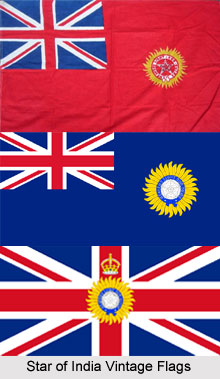 The Star of India refers to a group of flags that were used by the British administration during the time of British rule in the country. British India, also known as the Indian Empire had a wide range of flags that were utilised for different purposes during their reign. These flags included the Union Flag that contained the emblem of the Order of the Star of India which was superimposed. It also incorporated the Red or Blue Ensign with the Star of India superimposed. The Union Flag of the United Kingdom was the official state flag for use on land in India. On 15th August 1947, the Union Flag was lowered on the Indian Independence Day. The Union Flag was defaced with the insignia of the Order of the Star of India which was surmounted by the Tudor Crown. The Red Ensign with the Union Flag at the corner contained the Star of India which was displayed in the fly. The Blue Ensign with Union Flag at the corner consisted of the Star of India which was exhibited in the fly.
The Star of India refers to a group of flags that were used by the British administration during the time of British rule in the country. British India, also known as the Indian Empire had a wide range of flags that were utilised for different purposes during their reign. These flags included the Union Flag that contained the emblem of the Order of the Star of India which was superimposed. It also incorporated the Red or Blue Ensign with the Star of India superimposed. The Union Flag of the United Kingdom was the official state flag for use on land in India. On 15th August 1947, the Union Flag was lowered on the Indian Independence Day. The Union Flag was defaced with the insignia of the Order of the Star of India which was surmounted by the Tudor Crown. The Red Ensign with the Union Flag at the corner contained the Star of India which was displayed in the fly. The Blue Ensign with Union Flag at the corner consisted of the Star of India which was exhibited in the fly.
The Blue Ensign was primarily used for military and naval purposes, where as the Red Ensign was utilised for representing India in various international events. The Star of India comprised of a star that consisted of the words "Heaven`s light our guide" around them; and was the badge of the Order of the Star of India, also known as The Most Exalted Order of the Star of India, which was chivalric order of knighthood established by Queen Victoria in the year 1861. A blue state government flag also existed, which was included a lion holding a Tudor Crown.
After India achieved Independence on 15th of August 1947, the Star of India flags were removed and replaced by the Official Tricolour Indian flag, known as the Tiranga in the independent Union of India.
This article is a stub. You may enrich it by adding more information to it. You can send your write-up at content@indianetzone.com



















